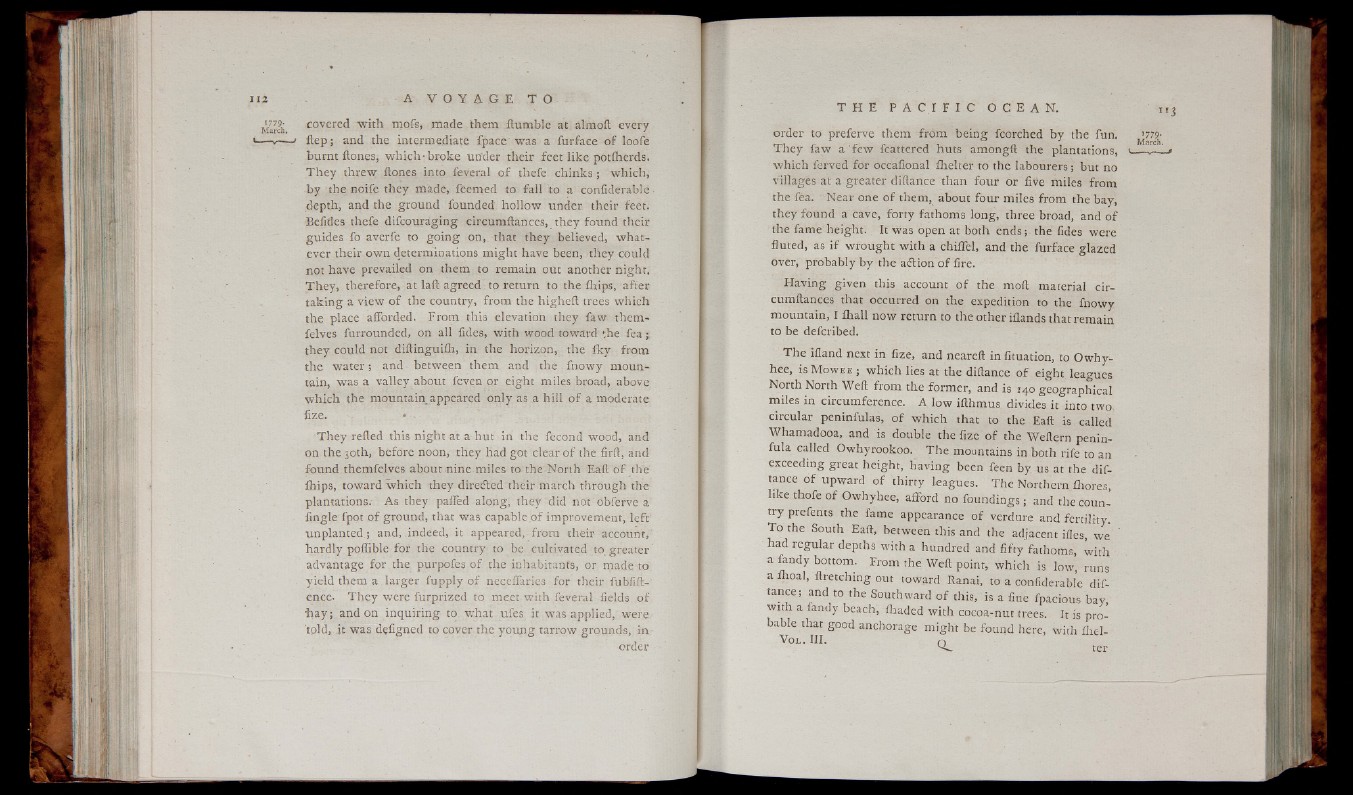
March covered w ith mofs, made them ftumble at almoft every
-—.— flep ; and the intermediate fpace was a furfaee o f loofe
burnt ftones, w h ich -b ro k e under their fee t lik e potfherds.
T h e y threw Hones into feveral o f thefe c h in k s ; w hich,
b y the noife they made, feemed to fa ll to a confiderable
depth, and the ground founded' h o llow under their feet.
Beiides thefe difcourag in g circumftances, they found their
gu ides fo averfe to g o in g on, that they believed, w hatever
their own determinations m igh t have been, the y could
not have prevailed on them to remain out another night.
T h e y , therefore, at laft agreed to return to the fhips, after
ta k in g a v iew o f the country, from the higheft trees which
the place afforded. From this elevation they faw them-
felves furrounded, on all fides, with wood toward the f e a ;
they could not diftinguiih, in the horizon, the ik y from
the w a t e r ; and between them and the fnow y mountain,
was a v a lley about feven or e ight miles broad, above
w h ich the mountain^ appeared only as a h ill o f a moderate
ftzc. •
T h e y relied this n ight at a hut in the fecond wood, and
on the 30th, before noon, the y had got clear o f the firft, and
foun d themfelves about nine miles to the North Eail o f the
lhips, toward w h ich they direéted their march throu gh the
plantations.- As they paffed along, they did not obferve a
fingle fpot o f ground, that was capable .of improvement, left
unplanted.; and, indeed, it appeared, from their account,'
hardly pofiible for the country to be cultivated to greater
advantage for the purpofes o f the inhabitants, or made to
y ie ld them a larger fupply o f neceffaries for their fubfift-
ence- T h e y were furprized to meet with feveral fields o f
•hay ; and on inquirin g to what ufes it was applied, were
'told, it was defigned to cover the y o u n g tarrow grounds, in
order
order to preferve them from b e in g fcorched b y the fun. ' 779-
T h e y faw a few fcattered huts amongft the plantations, 1 . -
w hich ferved for occafional ihelter to the lab ou re rs ; but no
village s at a greater diftance than fou r or five miles from
the fea. Near one o f them, about four miles from the bay,
they found a cave, fo rty fathoms long, three broad, and o f
the fame he ight. It was open at both en d s ; the fides were
fluted, as i f w rou gh t with a chiflel, and the furfaee glazed
over, probably b y the aition o f fire.
H a vin g g iv en this account o f the mofi material circumftances
that occurred on the expedition to the fnowy
mountain, I fhall now return to the other iflands tharremain
to be defcribed.
T h e ifland next in fize, and neareft in fituation, to O w h y -
hee, is M o w e e ; w hich lies at the diftance o f eight leagues
North North Weft from the former, and is 140 geographical
miles in circumference. A low ifthmus divides it into two,
circular peninfulas, o f w h ich that to the Eaft is called
Whamadooa, and is double the fize o f the Weftern penin-
fula called Owhyrookoo. T h e mountains in both rife to an
exceeding great h e ight, h a v in g been feen by us at the diftance
o f upward o f thirty leagues. The Northern ihores,
lik e thofe o f Owhyhee, afford no foundings ; and the country
prefents the fame appearance o f verdure and fertility.
To the South Eaft, between this and the adjacent ifles, we
had re gu la r depths with a hundred and fifty fathoms, with
a fandy bottom. From the Weft point, w hich is low, runs
a fhoal, ftretching out toward Ranai, to a confiderable diftance;
and to the Southward o f this, is a fine fpacious bay,
with a fandy beach, ihaded with cocoa-nut trees. It is probable
that good anchorage might be found here, with iliel-
V o l . III. n
^ ter